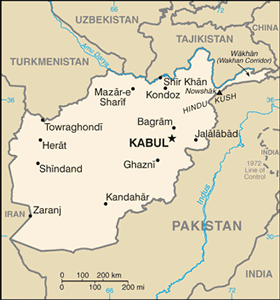The Geography of Afghanistan
The Geography of Afghanistan
Afghan Geography
Location: Southern Asia, north and west of Pakistan, east of Iran
Geographic coordinates: 33 00 N, 65 00 E
Map references: Asia
Area: total: 647,500 sq km land: 647,500 sq km water: 0 sq km
Area - comparative: slightly smaller than Texas
Land boundaries: total: 5,529 km border countries: China 76 km, Iran 936 km, Pakistan 2,430 km, Tajikistan 1,206 km, Turkmenistan 744 km, Uzbekistan 137 km
Coastline: 0 km (landlocked)
Maritime claims: none (landlocked)
Climate: arid to semiarid; cold winters and hot summers
Terrain: mostly rugged mountains; plains in north and southwest
Elevation extremes: lowest point: Amu Darya 258 m highest point: Nowshak 7,485 m
Natural resources: natural gas, petroleum, coal, copper, chromite, talc, barites, sulfur, lead, zinc, iron ore, salt, precious and semiprecious stones
Land use: arable land: 12.13% permanent crops: 0.21% other: 87.66% (2005)
Irrigated land: 27,200 sq km (2003)
Natural hazards: damaging earthquakes occur in Hindu Kush mountains; flooding; droughts
Environment - current issues: limited natural fresh water resources; inadequate supplies of potable water; soil degradation; overgrazing; deforestation (much of the remaining forests are being cut down for fuel and building materials); desertification; air and water pollution
Environment - international agreements: party to: Biodiversity, Climate Change, Desertification, Endangered Species, Environmental Modification, Marine Dumping, Ozone Layer Protection signed, but not ratified: Hazardous Wastes, Law of the Sea, Marine Life Conservation
Geography - note: landlocked; the Hindu Kush mountains that run northeast to southwest divide the northern provinces from the rest of the country; the highest peaks are in the northern Vakhan (Wakhan Corridor)


